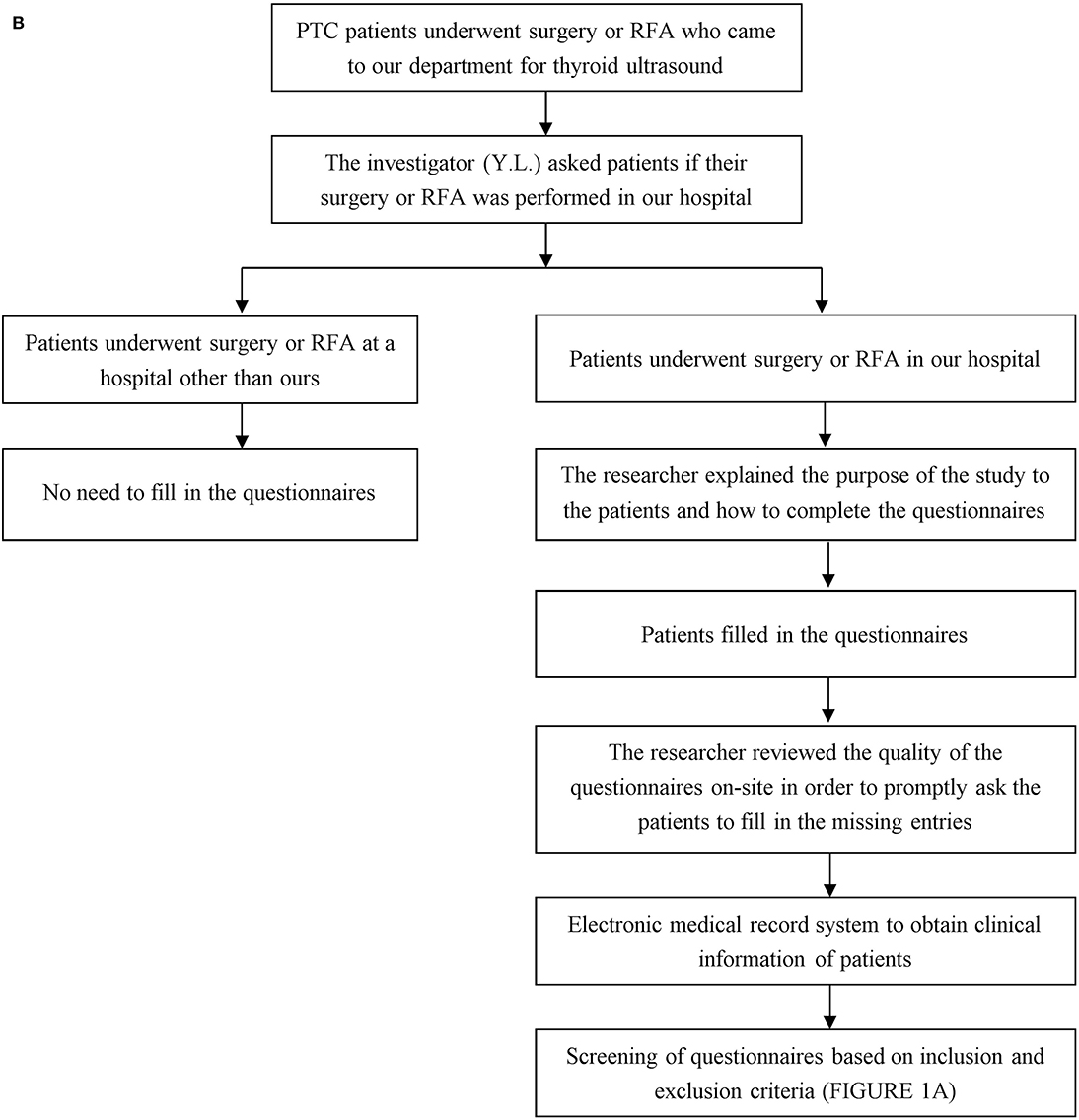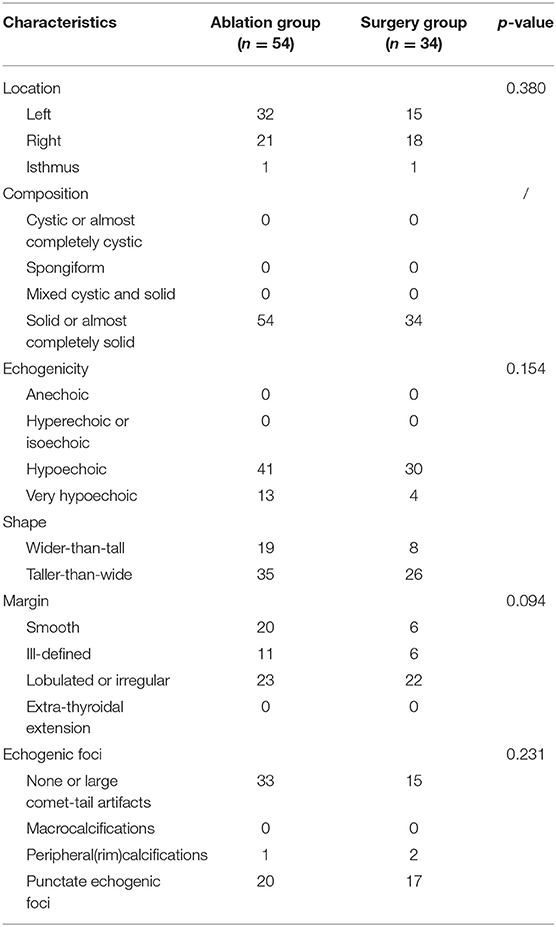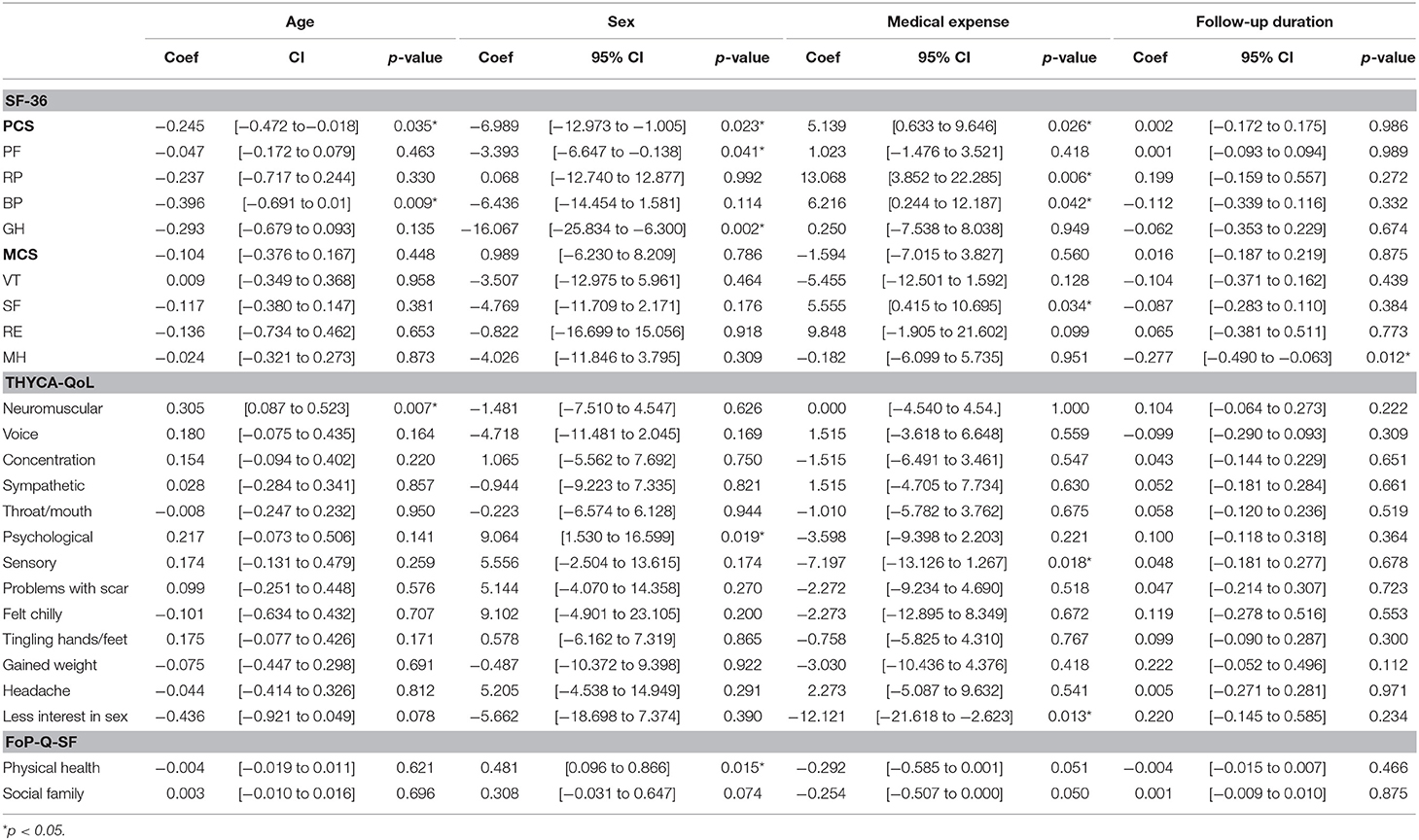- 1School of Medicine, Nankai University, Tianjin, China
- 2Department of Ultrasound, The First Medical Center of Chinese PLA General Hospital, Beijing, China
- 3Department of Ultrasound, The People's Hospital of Liaoning Province, Shenyang, China
Objective: Papillary thyroid microcarcinoma (PTMC) has a good prognosis and a long survival time. Health-related quality of life (HRQoL) is vital for PTMC patients during their survivorship. Ultrasound (US)-guided radiofrequency ablation (RFA), which has high efficacy and safety, is recommended as an alternative treatment to surgery for the patients with low-risk PTMC. However, the assessment of QoL of patients with PTMC has not been specially reported. The purpose of our study was to compare the HRQoL of patients with PTMC who underwent RFA and those who underwent surgery.
Methods: From October 2019 to December 2019, 88 PTMC patients were enrolled in our study, including 54 in RFA group and 34 in surgery group. We used three questionnaires which included the 36-item short form health survey (SF-36), thyroid cancer-specific quality of life (THYCA-QOL), and Fear of Progression Questionnaire-Short Form (FoP-Q-SF) for each patient to evaluate their scores of HRQoL. The scores were compared after adjusting for age, sex, medical expense, and follow-up time.
Results: According to the SF-36, the scores of the domain for the role limitation due to physical problems and emotional problems (RP, RE) as well as Physical Component Summary (PCS) showed a significant negative linear association between the RFA group and surgery group: RP coefficient [coef]−22.613 [confidence interval (CI) −33.504 to −11.723], p < 0.001, RE (coef: −21.901 [CI −36.737 to −7.064], p = 0.004), and PCS (coef: −8.312 [CI −13.694 to −2.930], p = 0.003). The THYCA-QOL showed that the scores of the surgery group were higher than that of the RFA group regarding scars (coef: 10.246 [CI 1.330 to 19.162], p = 0.025 according to the multivariate analysis), suggesting a higher level of complaint in the surgery group. There was no statistically significant difference in the scores of FoP-Q-SF between the two groups.
Conclusions: In patients with PTMC, US-guided RFA offers advantage over surgery in terms of HRQoL, which supports the role of RFA as an alternative strategy to surgery.
Introduction
Papillary thyroid microcarcinoma (PTMC), which is papillary thyroid carcinoma (PTC) with a maximum diameter of ≤ 1 cm (1, 2), has high incidence, low mortality rate, and over 90% 10-year survival rate (3–6). Although it is often referred to as the “good cancer,” health-related quality of life (HRQoL) is often reduced by sleep disorders, fatigue, and limited daily activity compared with general people (7, 8). Studies showed that HRQoL of thyroid cancer survivors is negatively affected for up to 20 years after treatment (9). Thus, more attention should be paid to the HRQoL of patients when choosing treatment strategy (10).
The recent American Thyroid Association (ATA) Guidelines also emphasize that physicians should consider long-term quality of life outcomes when making treatment decisions, and recommend active surveillance (AS) for PTMC (2). However, patients who worry about untreated tumors or tumor metastases may experience significant psychological stress (11). Although surgery is a general recommendation of treatment (2, 12–14), it may cause some complications such as permanent recurrent laryngeal nerve paralysis, hypothyroidism, hypoparathyroidism, or an ugly scar (15–19), which may decrease QoL of thyroid cancer survivors and negatively affect their psychological well-being and social function (7, 20).
Ultrasound (US)-guided thermal ablation has become a new treatment strategy for thyroid nodules (21–25). The efficacy and safety of microwave ablation and radiofrequency ablation (RFA) in the treatment of thyroid microcarcinoma have been demonstrated in previous studies (26–28). However, the comparative study of the quality of life for thyroid cancer patients between undergoing surgery and thermal ablation has not been reported yet.
In this study, we sought to make the comparison of HRQoL between the low-risk PTMC patients who underwent US-guided RFA and surgery by using three different and validated questionnaires.
Materials and Methods
Patients
The comparative study was approved by the Institutional Review Board at General Hospital of Chinese PLA (S2019-211-01). Informed consent for treatment and questionnaire procedures was obtained from each participant. From October 2019 to December 2019, 88 patients (15 male and 73 female with an average age of 42.09 years ± 10.02 years ranging from 23 years to 64 years) who had undergone RFA or open surgery in our hospital were enrolled in our study (Figure 1A).
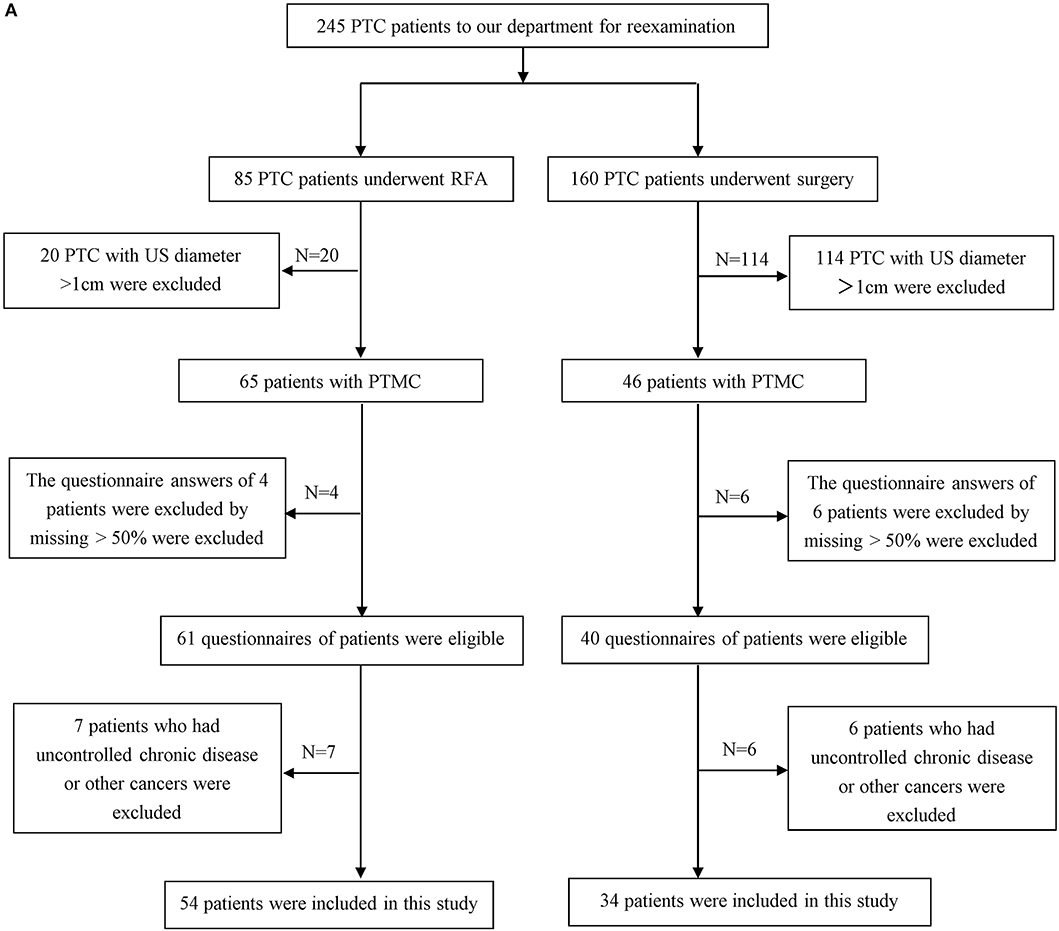
Figure 1A. The flow chart of inclusion and exclusion of the RFA and surgery group. PTC, papillary thyroid carcinoma; PTMC, papillary thyroid microcarcinoma; US, ultrasound.
For the RFA group, patients were enrolled in this study if they fulfilled the following criteria: (1) a solitary suspicious thyroid nodule with a maximum diameter of less than 1 cm was detected by US; (2) low-risk PTMC, which is defined as patients without any evidence of nodal or distant metastases, extrathyroidal extension, or history of radiation exposure (2, 12); (3) core needle biopsy (CNB) confirming PTMC without aggressive histological type (except hobnail, poorly differentiated, or tall cell variants) (29); (4) patients refused surgery or were poor candidates for surgery; and (5) more than 1 month's follow-up.
For the surgery group, patients had undergone surgery and were included in this study if they fulfilled the following criteria: (1) a solitary suspicious thyroid nodule with a maximum diameter of ≤ 1 cm detected by pre-operative US; (2) low-risk PTMC, which is defined as patients without any evidence of nodal or distant metastases, extrathyroidal extension, or history of radiation exposure (2, 12); (3) surgical pathology confirming PTMC without aggressive histological type and no other aggressive features; and (4) more than 1 month's follow-up.
A total of 54 PTMC patients underwent RFA, two of whom were poor candidates for surgery due to chronic cardiac insufficiency, and 52 of whom subjectively refused open surgery or active surveillance. 34 PTMC patients underwent surgery, with 16 patients who underwent total thyroidectomy and 18 patients who underwent unilateral lobectomy.
All PTC patients who underwent surgery or RFA came to our department for review and filled in the questionnaire, and the questionnaire screening process was completed by the investigator (Y.L.) alone. The characteristics of tumors and surgical methods of the patients were obtained from the electronic medical record system of our hospital, and the questionnaires of the patients meeting the inclusion criteria were enrolled in this study (Figure 1B).
Ablation Procedure
In our study, all patients underwent routine US and contrast-enhanced ultrasonography (CEUS) examination before ablation by using a 15L8W linear array transducer and a real-time US System (Siemens ACUSON Sequoia 512, Siemens, Mountain View, CA), a L12-5 linear array transducer and a real-time US System (Philips EPIQ7, Philips Healthcare, Bothell, WA), or a L12-4 linear array transducer and a real-time US System (Mindray M9, Mindray, Shenzhen, China). Routine US characteristics of lesions including location, composition, echogenicity, shape, margin, and echogenic foci (Table 1) were assessed and recorded according to the ACR TI-RADS (30). All RFA procedures were performed by the same sonographer (K.Y.L.), who has 20 years' clinical experience in routine and interventional US.
Patients lay in the supine position with their necks extended. Skin sterilization was performed and 1% lidocaine was used for local anesthesia at the intended puncture site. The hydrodissection technique was used with a mixture of 1% lidocaine injected into the anterior capsule space and normal saline injected into the posterior capsule space to protect vital structures (cervical artery, trachea, esophagus, recurrent laryngeal nerve) to prevent thermal injury when the distance between the lesion and the surrounding vital structures was <5 mm. Moving-shot ablation technique was used to perform the RFA. (22, 25). The RFA extends beyond the edge of the lesion to prevent local residue and recurrence. When all the target areas become transient hyperechoic zones, the ablation stops. During the procedure, more attention would be paid to protecting the surrounding vital structures to prevent serious complications such as hematoma formation or nerve injury. After RFA, all patients were observed for 1 to 2 h and were evaluated for any complications during or immediately after RFA operation.
Surgery Procedure
Patients in the surgery group were operated on by surgeons (W.T. or Z.Q.) with more than 20 years of experience in thyroid surgery. They complete more than 1,000 surgical procedures each year. Surgical procedures are performed according to the ATA guidelines (2), including unilateral lobectomy or total thyroidectomy with or without cervical lymph node dissection and iodine therapy.
Demographic and Clinical Characteristics
Demographic characteristics, such as age, sex, height, weight, marital status, education level, employment status, source of medical expenses, and place to live, were collected. Clinical characteristics such as data regarding levothyroxine (LT4) supplementation, comorbidity, and family history of thyroid cancer were collected.
HRQoL Questionnaires
Short-Form Survey
The SF-36 (Chinese version) is a multi-purpose short form survey, a well-validated and standardized questionnaire measuring HRQoL that is used in many publications (31–35). It consists of 36 questions measuring eight domains: physical functioning (PF), role-physical (RP), bodily pain (BP), general health (GH), vitality (VT), social functioning (SF), role-emotional (RE), and mental health (MH). Two total scores can be calculated: physical component summary (PCS) and mental component summary (MCS) representing the physical wellbeing and emotional wellbeing, respectively. All scores of domains are transformed to scales of 0 to 100. The higher scores on the domains indicate lower disability and better HRQoL.
Thyroid Cancer-Specific Quality of Life Questionnaire (THYCA-QOL)
The Chinese version of THYCA-QOL was used to assess the thyroid-specific symptoms resulting from the thyroid cancer itself or its treatment (36). It includes 24 questions measuring seven symptom domains (neuromuscular, voice, attention, sympathetic, throat/mouth, psychological, and sensory symptoms), as well as six single scales (scar, feeling cold, tingling sensation, weight gain, headache, and reduced sexual interest) (7, 37). The questionnaire has a strict time scale (4 weeks for the sexual interest item, 1 week for the other items). All items are classified into four levels (1 = “not at all,” 2 = “a little,” 3 = “quite a bit,” and 4 = “very much”) and are counted as 1 to 4 points. A higher score represents more complaints and worse HRQoL caused by that symptom (37).
Fear of Progression Questionnaire
This questionnaire was developed by Mehnert et al. (38) and has been applied to patients with systemic sclerosis (39) and cancer (40) with high reliability and validity. It consists of 12 items measuring two domains (physiological health dimension and social family dimension). The Likert 1 to 5 score method is adopted. Each item is scored from 1 to 5: “never” to “often.” The scale is self-rated by patients with a total score of 12 to 60 points. A higher score indicates a greater level of anxiety about disease progression.
All questionnaires in this study were sent and received by the investigator (Y.L.), who explained the method of filling in the questionnaires. The three questionnaires mentioned above were completed after obtaining the patients' informed consent. The researcher checked whether the questionnaire was wrongly written or omitted and corrected in time.
Statistical Analysis
Categorical variables were expressed as numbers, and continuous variables were presented as the mean and standard deviation. Continuous variables were compared using t-test. By using univariate and multivariate regression analyses, we compared the differences in scores between RFA group and surgery group. The age, sex, medical expense, and interval time were adjusted in multivariate model. All p-values were two-sided, and p < 0.05 was considered as statistically significant difference. The SPSS statistical software (version 24.0; IBM, Inc., Chicago, IL) was used to perform all statistical analyses, and the figures were generated using Graph Pad Prism 8.0 (Graph Pad Software, Inc., San Diego, CA).
Results
Baseline Characteristics of the Patients
Baseline characteristics had no difference between the RFA group and surgery group in age, sex, BMI, marital status, education level, employment status, comorbidity, family history of thyroid cancer, place to live, and LT4 supplementation. However, in comparison to the patients in the RFA group, patients who underwent surgery were more likely to be patients who can receive medical reimbursement. The time interval from operation to questionnaires completion was also significantly different (5.57 months vs. 20.29 months, p < 0.001; Table 2). Meanwhile, there was no significant difference in the baseline characteristics of patients in the unilateral lobectomy group and the total lobectomy group (all p > 0.05, Table 2).
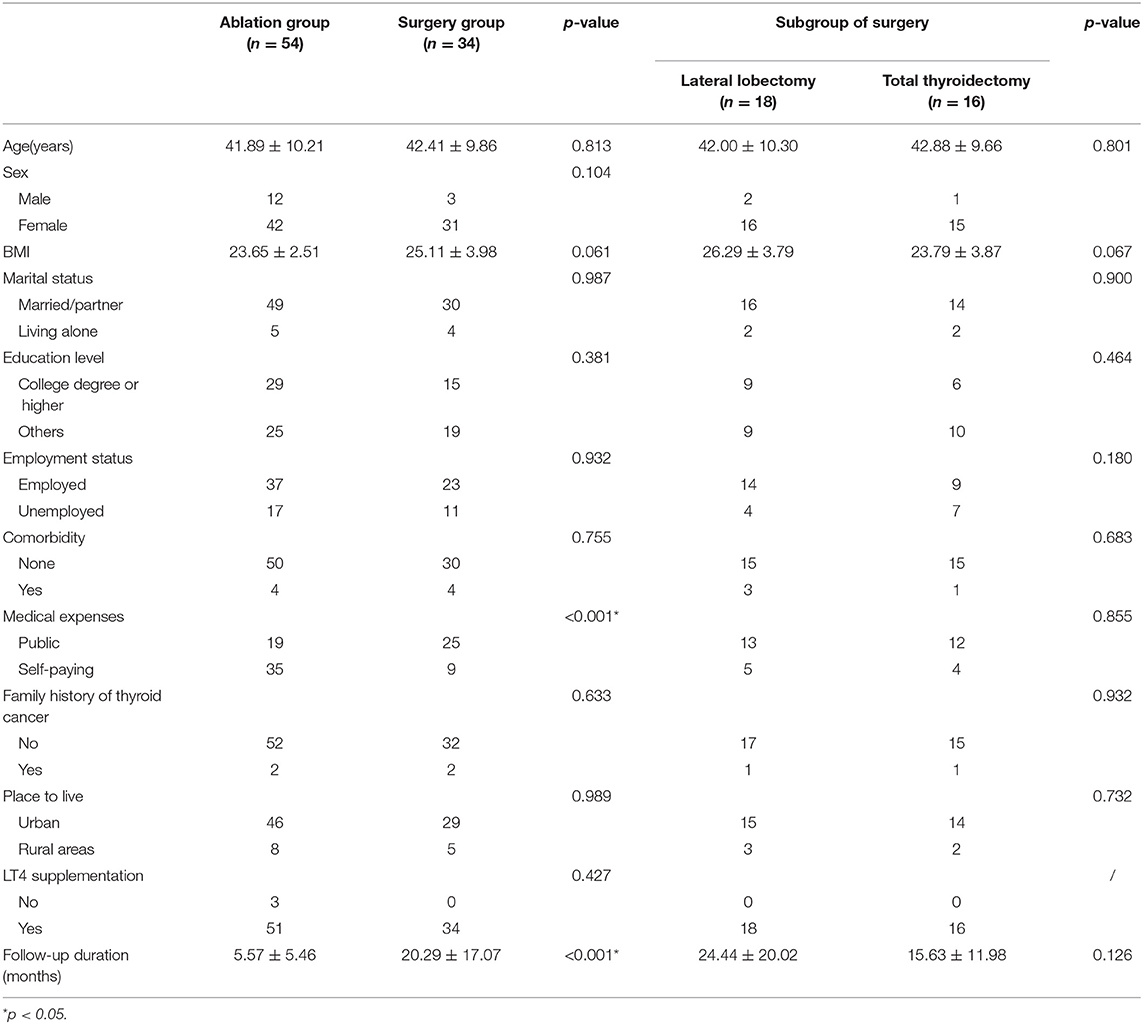
Table 2. Baseline characteristics of papillary thyroid microcarcinoma patients in RFA group and surgery group.
Among the 34 patients who underwent open surgery, two experienced postoperative hoarse voice. One patient recovered 1 month after surgery and another one was still not recovered at the time of questionnaire completion (3 months after surgery). No complications occurred in the RFA group in this study.
In order to find out the factors related to the HRQoL of PTMC patients, univariate analysis was performed. Both sex and medical expense as categorical variables, as well as age and follow-up duration as continuous variables, are associated with many HRQoL parameters (Table 3). Thus, in order to control the interference of confounding factors, the variables for age, sex, medical expenses, and follow-up time were adjusted during the multivariate analysis.
SF-36 Questionnaire Scores
The RP, BP, SF, RE, and PCS scores of patients in the RFA group were clearly higher than that in the surgery group (Figure 2). In both univariate and multivariate analyses, the RP, RE, and PCS scores showed a significant negative linear association between RFA group and the surgery group: RP (coefficient [coef] −22.613 [confidence interval (CI) −33.504 to −11.723], p < 0.001, RE (coef: −21.901 [CI −36.737 to −7.064], p = 0.004), and PCS (coef: −8.312 [CI −13.694 to −2.930], p = 0.003). The results suggested that the physical wellbeing of patients in the RFA group was better than in the surgery group (Table 4). In addition, RP, SF, and PCS scores of patients in the unilateral lobectomy group were clearly higher than that in the total thyroidectomy (Table 5).
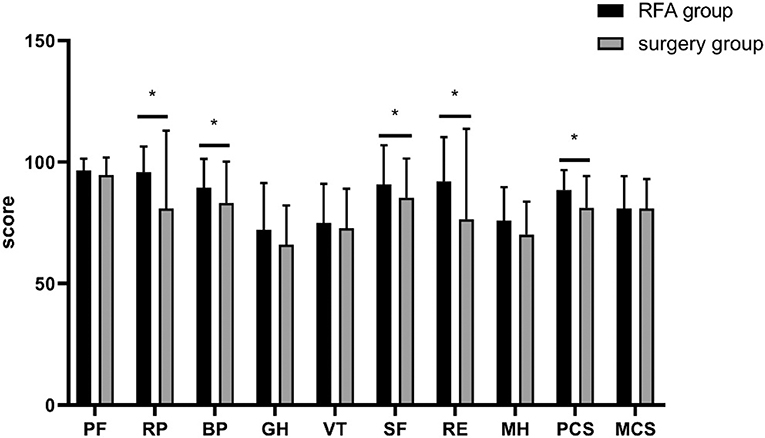
Figure 2. SF-36 score comparison between patients with PTMC in the RFA group and in the surgery group: the patients in the RFA group showed significantly higher scores than the surgery group in 4 domains of HRQoL (*p < 0.05).
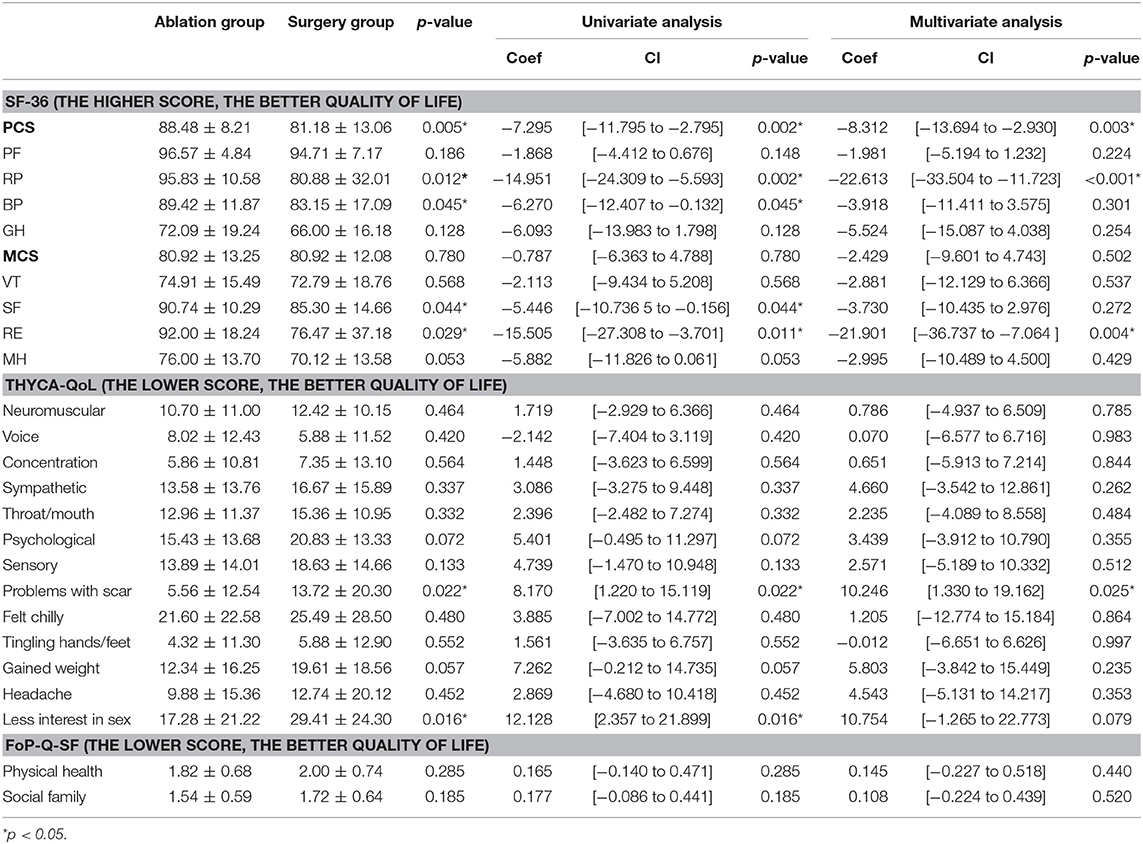
Table 4. Comparison of quality of life in patients with papillary thyroid microcarcinoma who underwent ablation vs. those who underwent surgery.
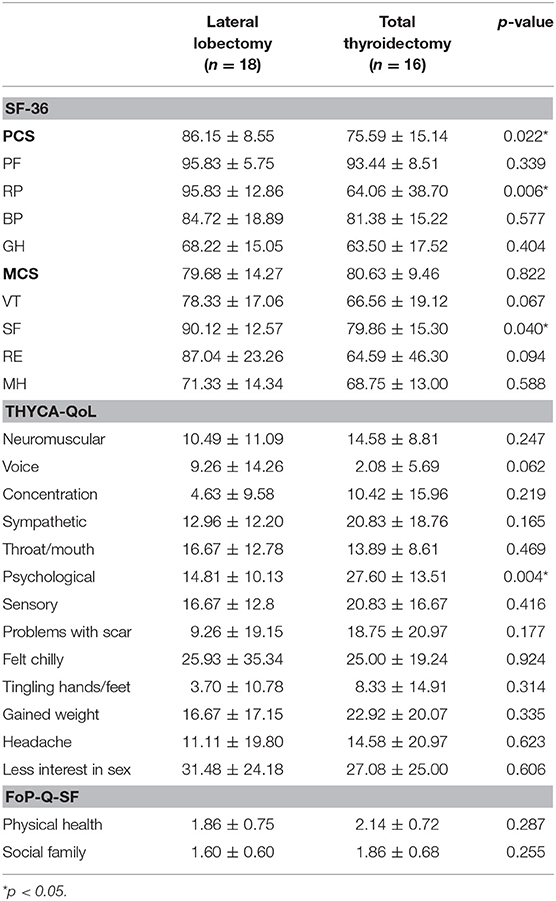
Table 5. Comparison of quality of life in patients with papillary thyroid microcarcinoma who underwent unilateral lobectomy vs. those who underwent total thyroidectomy.
THYCA-QOL Questionnaire Scores
The “problems with scarring” and “less interest in sex” scale scores of patients in the RFA group were lower than in the surgery group, indicating a lower level of complaint relating to symptom in the RFA group (Table 4, Figure 3). In both univariate and multivariate analyses, the “problems with scarring” scale score showed a significant positive linear association between groups (coef: 10.246 [CI 1.330 to 19.162], p = 0.025 according to the multivariate analysis). The “less interest in sex” scale score showed a significant difference between the two groups in the univariate analysis but in the multivariate analysis there was no significant difference (Table 4). Psychological scores were clearly higher in the unilateral lobectomy group than in the total thyroidectomy (Table 5).
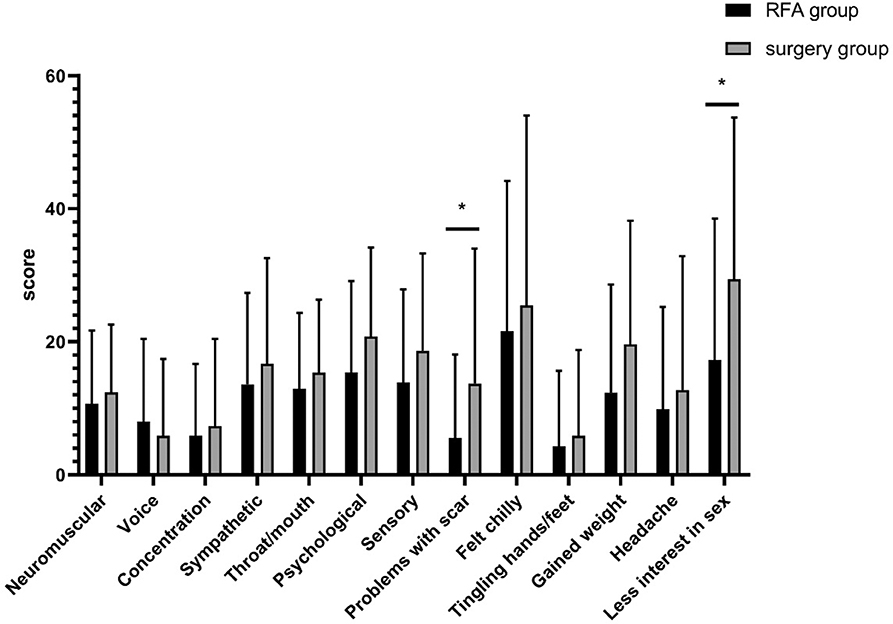
Figure 3. THYCA-QoL score comparison between patients with PTMC in the RFA group and in the surgery group: the patients in the RFA group showed significantly lower scores than the surgery group in 2 domains of HRQoL (*p <0.05).
FoP-Q-SF Questionnaire Scores
Neither physical health nor social family domain had significant differences in FoP-Q-SF questionnaire scores between the two groups in all analyses (p > 0.05) (Table 4).
Discussion
With the development of medicine, the definition of health has been changing (41), which is defined as a combination of physical, emotional, and social potential, not simply the absence of disease. Additionally, HRQoL reflects personal satisfaction or happiness with their life, and to some extent it may affect or be affected by a certain aspect of the “health” definition mentioned above. Thus, HRQoL has been introduced as an assessment of an individual's health status. The recent ATA Guidelines also emphasize the importance of long-term HRQoL outcomes when physicians make treatment decisions (2).
Our study evaluated the HRQoL of patients with PTMC under different treatment strategies. Several significant differences were found in parameters of the SF-36 questionnaires between the RFA group and the surgery group. After adjusting for age, sex, medical expense, and follow-up duration, the surgery group reported more problems associated with PCS, RP, and RE than the RFA group. RP and RE represent restrictions on daily activities or work due to physical and emotional effects, respectively. PCS represents the overall physical health of the patients. Therefore, patients in the surgery group suffered more adverse effects than those in the RFA group, especially for those who underwent total thyroidectomy. The result is consistent with the results of Lubitz CC et al., which reported that the domain of RE remained decreased years after surgery even without the recurrence of PTC (42).The cause may be due to surgical trauma or complications (43). In general, the greater the surgical trauma, the more likely it is to cause complications (44, 45). According to research reports, the probability of permanent recurrent laryngeal nerve injury after surgery is 0 to 12%, and the probability of permanent hypocalcemia is 0 to 7% (46–48). However, RFA seems to present fewer complications (48). In our study, no patients in the RFA group reported complications. Therefore, we believe that the smaller the trauma, the lower the possibility of complications and the higher the quality of life in patients with PTMC.
In addition, the THYCA-QoL questionnaire used in our study had an item about scarring problems. The problem of scarring was more common in patients who underwent surgery than those who underwent RFA. This was one of the major causes of quality of life decline in the surgery group. Previous studies had revealed that an obvious scar may negatively affect the HRQoL of PTC patients (49) because of the majority of women with thyroid cancer and a good prognosis, a significant number of patients are concerned about permanent and unsightly scars. Although surgery was recommended, the concerns about scarring may affect the HRQoL of survivors from seemly minor problems such as difficulties in choosing clothes to more significant problem such as avoiding communicating with others and developing an inferiority complex, even influencing their career development (50). Additionally, quite a lot of patients may think that the apparent scar may have caused damage to their body image, which is a definition of an individual's subjective view of their own body and has to do with self-esteem and self-perception, closely related with HRQoL.
Some studies had revealed that patients with post-treatment thyroid cancer are constantly concerned about recurrence and metastasis during long-term follow up (51). Hedman et al. reported that only 7% of patients actually experience disease recurrence, but up to 48% of thyroid cancer patients are under pressure to worry about recurrence, which has seriously affected their quality of life (52). The perceptions of the disease from thyroid cancer survivors are often subjective and emotional, and may be inconsistent with the actual severity of the disease. However, in our study, it had no significant difference between the RFA group and the surgery group in the analysis of anxieties and fears associated with disease progression using the FoP-Q-SF questionnaire. This reveals that the patients in the RFA group were not more concerned about the progression of the disease although ablative therapy was only localized to the lesion, which was one of the main concerns during the follow-up of patients who underwent RFA. However, the patients in the RFA group reported less interest in sexual activity with no statistical significance after adjustment in the multivariate analysis, which may be associated with some anxiety resulting from cancer itself (53).
The three questionnaires used in this study have been demonstrated by previous studies to be validated in evaluating patients' HRQoL. Among them, SF-36 is considered to be a commonly used and sensitive instrument in measuring HRQoL in thyroid cancer in previous studies (54). Gou J et al. reported that RP, RE, and PCS of SF-36 were the factors associated with the HRQoL of patients with PTMC (43). These results are consistent with our study. It indicates that SF-36 is an appropriate tool to evaluate HRQoL of thyroid cancer survivors. However, the SF-36 cannot evaluate all aspects of HRQoL such as disease symptoms or treatment side effects. Thus, the THYCA-QoL questionnaire and FoP-Q-SF were included as a reasonable complement to evaluate important aspects regarding thyroid cancer-specific symptoms (7) and fear of disease progression, which may be the strong determinants of the quality of life after thyroid cancer.
Since the strategy of RFA was first introduced in patients with PTMCs, many studies reported its safety and efficacy for treating low-risk PTMCs (26, 55). Our study suggests that RFA may have advantages in improving the HRQoL of patients with no relationship to anxiety or fear associated with disease progression.
This study has several limitations. First, the baseline characteristics of patients between the two treatment groups were not all matched even though the multivariate analysis was adjusted for patients' follow-up duration, which was a key factor in the assessment of HRQoL (56) as well as medical expense (57). Thus, the results of this study can be biased. Second, the number of patients included in our study was limited. Third, the follow-up time is not long enough, which may overestimate the negative impact of surgery to HRQoL (58), since the HRQoL of cancer patients may improve over time after surgery (7). Last, preoperative quality of life was unknown in both groups. Thus, prospective studies with large samples and longer-term follow-up are proposed.
In conclusion, our study suggested that US-guided RFA offers advantage in terms of HRQoL and supports the role of ablation as an alternative strategy for patients with PTMC except for surgery.
Data Availability Statement
The data used to support the findings of this study are available from the corresponding author upon request.
Ethics Statement
The studies involving human participants were reviewed and approved by institutional review board of General Hospital of Chinese PLA (S2019-211-01). The patients/participants provided their written informed consent to participate in this study. Written informed consent was obtained from the individual(s) for the publication of any potentially identifiable images or data included in this article.
Author Contributions
YLu: integrity of the whole study, analysis of data, and review of final manuscript. YLa and MZ: management of data and manuscript writing. LY and YZ: statistical analysis of data. ZJ and JX: literature review and input of scores in questionnaires. YLa: distribution and recovery of questionnaires, collection and analysis of data.
Funding
This study was funded by the National Natural Science Foundation of China (Grant No. 81771834).
Conflict of Interest
The authors declare that the research was conducted in the absence of any commercial or financial relationships that could be construed as a potential conflict of interest.
Acknowledgments
We are grateful for the technical assistance of Dr. Zhi Qiao and Dr. Wen Tian from the Department of General Surgery, General Hospital of Chinese PLA, Beijing, China.
References
1. Jeon MJ, Kim WG, Kwon H, Kim M, Park S, Oh HS, et al. Clinical outcomes after delayed thyroid surgery in patients with papillary thyroid microcarcinoma. Eur J Endocrinol. (2017) 177:25–31. doi: 10.1530/EJE-17-0160
2. Haugen BR, Alexander EK, Bible KC, Doherty GM, Mandel SJ, Nikiforov YE, et al. 2015 american thyroid association management guidelines for adult patients with thyroid nodules and differentiated thyroid cancer: the american thyroid association guidelines task force on thyroid nodules and differentiated thyroid cancer. Thyroid. (2016) 26:1–133. doi: 10.1089/thy.2015.0020
3. Abdelgadir Adam M, Pura J, Goffredo P, Dinan MA, Hyslop T, Reed SD, et al. Impact of extent of surgery on survival for papillary thyroid cancer patients younger than 45 years. J Clin Endocrinol Metab. (2015) 100:115–21. doi: 10.1210/jc.2014-3039
4. Gartland RM, Lubitz CC. Impact of extent of surgery on tumor recurrence and survival for papillary thyroid cancer patients. Ann Surg Oncol. (2018) 25:2520–5. doi: 10.1245/s10434-018-6550-2
5. Siegel R, Naishadham D, Jemal A. Cancer statistics, 2012. Cancer J Clin. (2012) 62:10–29. doi: 10.3322/caac.20138
6. Davies L, Welch HG. Current thyroid cancer trends in the united states. JAMA. (2014) 140:317. doi: 10.1001/jamaoto.2014.1
7. Husson O, Haak HR, Buffart LM, Nieuwlaat W, Oranje WA, Mols F, et al. Health-related quality of life and disease specific symptoms in long-term thyroid cancer survivors: a study from the population-based pROFILES registry. Acta Oncol. (2013) 52:249–58. doi: 10.3109/0284186X.2012.741326
8. Gamper E, Wintner LM, Rodrigues M, Buxbaum S, Nilica B, Singer S, et al. Persistent quality of life impairments in differentiated thyroid cancer patients: results from a monitoring programme. Eur J Nucl Med. (2015) 42:1179–88. doi: 10.1007/s00259-015-3022-9
9. Hoftijzer HC, Heemstra KA, Corssmit EPM, van der Klaauw AA, Romijn JA, Smit JWA. Quality of life in cured patients with differentiated thyroid carcinoma. J Clin Endocrinol Metab. (2008) 93:200–3. doi: 10.1210/jc.2007-1203
10. Davies L, Welch HG. Increasing incidence of thyroid cancer in the United States, 1973-2002. JAMA. (2006) 295:2164–7. doi: 10.1001/jama.295.18.2164
11. Yeh MW, Bauer AJ, Bernet VA, Ferris RL, Loevner LA, Mandel SJ, et al. American thyroid association statement on preoperative imaging for thyroid cancer surgery. Thyroid. (2015) 25:3–14. doi: 10.1089/thy.2014.0096
12. Pacini F, Schlumberger M, Dralle H, Elisei R, Smit JWA, Wiersinga W. European consensus for the management of patients with differentiated thyroid carcinoma of the follicular epithelium. Eur J Endocrinol. (2006) 154:787–803. doi: 10.1530/eje.1.02158
13. Watkinson JC, British TA. The british thyroid association guidelines for the management of thyroid cancer in adults. Nucl Med Commun. (2004) 25:897–900. doi: 10.1097/00006231-200409000-00006
14. Gharib H, Papini E, Garber JR, Duick DS, Harrell RM, Hegedüs L, et al. American association of clinical endocrinologists, american college of endocrinology, and associazione medici endocrinologi medical guidelines for clinical practice for the diagnosis and management of thyroid nodules−2016 update. Endocr. Pract. (2016). 22:622–39. doi: 10.4158/EP161208.GL
15. Gharib H. Changing trends in thyroid practice: understanding nodular thyroid disease. Endocr Pract. (2004) 10:31–9. doi: 10.4158/EP.10.1.31
16. Rafferty MA, Goldstein DP, Rotstein L, Asa SL, Panzarella T, Gullane P, et al. Completion thyroidectomy versus total thyroidectomy: is there a difference in complication rates? An analysis of 350 patients. J Am Coll Surgeons. (2007) 205:602–7. doi: 10.1016/j.jamcollsurg.2007.05.030
17. Mazzaferri EL. Management of a solitary thyroid nodule. N Eng J Med. (1993) 328:553–9. doi: 10.1056/NEJM199302253280807
18. Linos D, Economopoulos KP, Kiriakopoulos A, Linos E, Petralias A. Scar perceptions after thyroid and parathyroid surgery: comparison of minimal and conventional approaches. Surgery. (2013) 153:400–7. doi: 10.1016/j.surg.2012.08.008
19. Lang BH, Lo C. Total thyroidectomy for multinodular goiter in the elderly. Am J Surg. (2005) 190:418–23. doi: 10.1016/j.amjsurg.2005.03.029
20. Maeda T, Saito M, Otsuki N, Morimoto K, Takahashi M, Iwaki S, et al. Voice quality after surgical treatment for thyroid cancer. Thyroid. (2013). 23:847–53. doi: 10.1089/thy.2012.0060
21. McLeod DS, Sawka AM, Cooper DS. Controversies in primary treatment of low-risk papillary thyroid cancer. Lancet. (2013) 381:1046–57. doi: 10.1016/S0140-6736(12)62205-3
22. Kim YS, Rhim H, Tae K, Park DW, Kim ST. Radiofrequency ablation of benign cold thyroid nodules: initial clinical experience. Thyroid. (2006) 16:361–7. doi: 10.1089/thy.2006.16.361
23. Lim HK, Lee JH, Ha EJ, Sung JY, Kim JK, Baek JH. Radiofrequency ablation of benign non-functioning thyroid nodules: 4-year follow-up results for 111 patients. Eur Radiol. (2013). 23:1044–9. doi: 10.1007/s00330-012-2671-3
24. Hong MJ, Sung JY, Baek JH, Je MS, Choi DW, Yoo H, et al. Safety and efficacy of radiofrequency ablation for nonfunctioning benign thyroid nodules in children and adolescents in 14 patients over a 10-Year period. J Vasc Interv Radiol. (2019) 30:900–06. doi: 10.1016/j.jvir.2018.10.034
25. Jeong WK, Baek JH, Rhim H, Kim YS, Kwak MS, Jeong HJ, et al. Radiofrequency ablation of benign thyroid nodules: safety and imaging follow-up in 236 patients. Eur Radiol. (2008) 18:1244–50. doi: 10.1007/s00330-008-0880-6
26. Zhang M, Tufano RP, Russell JO, Zhang Y, Zhang Y, Qiao Z, et al. Ultrasound-guided radiofrequency ablation versus surgery for low-risk papillary thyroid microcarcinoma: results of over 5 years' follow-up. Thyroid. (2020) 30:408–17 doi: 10.1089/thy.2019.0147
27. Kim JH, Baek JH, Sung JY, Min HS, Kim KW, Hah JH, et al. Radiofrequency ablation of low-risk small papillary thyroidcarcinoma: preliminary results for patients ineligible for surgery. Int J Hyperthermia. (2017) 33:212–9. doi: 10.1080/02656736.2016.1230893
28. Li J, Liu Y, Liu J, Yang P, Hu X, Qian L. A comparative study of short-term efficacy and safety for thyroid micropapillary carcinoma patients after microwave ablation or surgery. Int J Hyperther. (2019) 36:639–45. doi: 10.1080/02656736.2019.1626492
29. Lloyd RV, Osamura RY, Klöppel G, Rosai J. WHO Classification of Tumours: Pathology and Genetics of Tumours of Endocrine Organs, 4th ed. Lyon: IARC Press (2017).
30. Tessler FN, Middleton WD, Grant EG. Thyroid imaging reporting and data system (TI-RADS): a User's guide. Radiology. (2018) 287:29. doi: 10.1148/radiol.2017171240
31. Promberger RMD, Hermann MMD, Pallikunnel SJMD, Seemann RMD, Meusel MMD, Ott JMD. Quality of life after thyroid surgery in women with benign euthyroid goiter: influencing factors including hashimoto's thyroiditis. Am J Surg. (2014) 207:974–9. doi: 10.1016/j.amjsurg.2013.05.005
32. Huang JK, Ma L, Song WH, Lu BY, Huang YB, Dong HM. Quality of life and cosmetic result of single-port access endoscopic thyroidectomy via axillary approach in patients with papillary thyroid carcinoma. Onco Targets Ther. (2016) 9:4053–9. doi: 10.2147/OTT.S99980
33. Garratt A. Quality of life measurement: bibliographic study of patient assessed health outcome measures. BMJ. (2002) 324:1417. doi: 10.1136/bmj.324.7351.1417
34. Liu J, Qu B, Hu B, Jiang N, Wang D. The quality of life of men who have sex with men in china: reliability and validity testing of the sF-36 questionnaire. PLoS ONE. (2013) 8:e83362. doi: 10.1371/journal.pone.0083362
35. Yue W, Wang S, Lu F, Li X, Xu H, Sun L, et al. Quality of life and cost-Effectiveness of radiofrequency ablation versus open surgery for benign thyroid nodules: a retrospective cohort study. Sci Rep. (2016) 6:37838. doi: 10.1038/srep37838
36. Jie L, Jing G, Yuan T, Chenxi W, Xiaolin J, Qin L, et al. Reliability and validity of chinese version of thyroid cancer-specific quality of life (THYCA-QoL) questionnaire. Tumor. (2019) 39:178–87. doi: 10.3781/j.issn.1000-7431.2019.22.658
37. Husson O, Haak HR, Mols F, Nieuwenhuijzen GA, Nieuwlaat W, Reemst PH, et al. Development of a disease-specific health-related quality of life questionnaire (THYCA-QoL) for thyroid cancer survivors. Acta Oncol. (2013) 52:447–54. doi: 10.3109/0284186X.2012.718445
38. Mehnert A, Herschbach P, Berg P, Henrich G, Koch U. [Fear of progression in breast cancer patients–validation of the short form of the fear of progression questionnaire (FoP-Q-SF)]. Z Psychosom Med Psychother. (2006) 52:274–88. doi: 10.13109/zptm.2006.52.3.274
39. Kwakkenbos L, van den Hoogen FHJ, Custers J, Prins J, Vonk MC, van Lankveld WGJM, et al. Validity of the fear of progression questionnaire-short form in patients with systemic sclerosis. Arthrit. Care Res. (2012) 64:930–4. doi: 10.1002/acr.21618
40. Aghdam AM, Rahmani A, Nejad ZK, Ferguson C, Mohammadpoorasl A, Sanaat Z. Fear of cancer recurrence and its predictive factors among Iranian cancer patients. Indian J Palliative Care. (2014) 20:128–33. doi: 10.4103/0973-1075.132632
41. Wang R, Wu C, Zhao Y, Yan X, Ma X, Wu M, et al. Health related quality of life measured by sF-36: a population-based study in shanghai, china. BMC Public Health. (2008) 8:292. doi: 10.1186/1471-2458-8-292
42. Lubitz CC, De Gregorio L, Fingeret al, Economopoulos KP, Termezawi D, Hassan M, et al. Measurement and variation in estimation of quality of life effects of patients undergoing treatment for papillary thyroid carcinoma. Thyroid. (2017) 27:197–06. doi: 10.1089/thy.2016.0260
43. Gou J, Cheng W, Lei J, Pan Q, You W, Cai M, et al. Health-related quality-of-life assessment in surgical patients with papillary thyroid carcinoma. Medicine. (2017) 96:e8070. doi: 10.1097/MD.0000000000008070
44. Udelsman R. Treatment of persistent or recurrent papillary carcinoma of the thyroid–the good, the bad, and the unknown. J Clin Endocrinol Metab. (2010). 95:2061–3. doi: 10.1210/jc.2010-0583
45. Sippel RS, Chen H. Controversies in the surgical management of newly diagnosed and recurrent/residual thyroid cancer. Thyroid. (2009). 19:1373–80. doi: 10.1089/thy.2009.1606
46. Kim MK, Mandel SH, Baloch Z, Livolsi VA, Langer JE, Didonato L, et al. Morbidity following central compartment reoperation for recurrent or persistent thyroid cancer. Arch Otolaryngol. (2004). 130:1214–6. doi: 10.1001/archotol.130.10.1214
47. Al-Saif O, Farrar WB, Bloomston M, Porter K, Ringel MD, Kloos RT. Long-term efficacy of lymph node reoperation for persistent papillary thyroid cancer. J Clin Endocrinol Metab. (2010) 95:2187–94. doi: 10.1210/jc.2010-0063
48. Kim JH, Yoo WS, Park YJ, Park DJ, Yun TJ, Choi SH, et al. Efficacy and safety of radiofrequency ablation for treatment of locally recurrent thyroid cancers smaller than 2 cm. Radiology. (2015) 276:909–18. doi: 10.1148/radiol.15140079
49. Choi Y, Lee JH, Kim YH, Lee YS, Chang HS, Park CS, et al. Impact of postthyroidectomy scar on the quality of life of thyroid cancer patients. Ann Dermatol. (2014) 26:693–9. doi: 10.5021/ad.2014.26.6.693
50. Annunziata MA, Giovannini L, Muzzatti B. Assessing the body image: relevance, application and instruments for oncological settings. Support Care Cancer. (2012) 20:901–7. doi: 10.1007/s00520-011-1339-x
51. Bresner L, Banach R, Rodin G, Thabane L, Ezzat S, Sawka AM. Cancer-Related worry in canadian thyroid cancer survivors. J Clin Endocrinol Metab. (2015) 100:977–85. doi: 10.1210/jc.2014-3169
52. Hedman C, Djarv T, Strang P, Lundgren CI. Determinants of long-term quality of life in patients with differentiated thyroid carcinoma - a population-based cohort study in Sweden. Acta Oncol. (2016) 55:365–9. doi: 10.3109/0284186X.2015.1102965
53. Nagele E, Den Oudsten B, Greimel E, EORTC QOLG. How to evaluate sexual health in cancer patients: development of the eORTC sexual health questionnaire for cancer patients. Trans Androl Urol. (2015) 4:95–102. doi: 10.3978/j.issn.2223-4683.2014.11.08
54. Borget I, Bonastre J, Catargi B, Déandréis D, Zerdoud S, Rusu D, et al. Quality of life and cost-effectiveness assessment of radioiodine ablation strategies in patients with thyroid cancer: results from the randomized phase III ESTIMABL trial. J Clin Oncol. (2015) 33:2885–92. doi: 10.1200/JCO.2015.61.6722
55. Park HS, Baek JH, Park AW, Chung SR, Choi YJ, Lee JH. Thyroid radiofrequency ablation: updates on innovative devices and techniques. Korean J Radiol. (2017) 18:615. doi: 10.3348/kjr.2017.18.4.615
56. Smith AW, Bellizzi KM, Keegan THM, Zebrack B, Chen VW, Neale AV, et al. Health-Related quality of life of adolescent and young adult patients with cancer in the united states: the adolescent and young adult health outcomes and patient experience study. J Clin Oncol. (2013) 31:2136–45. doi: 10.1200/JCO.2012.47.3173
57. Schultz PN, Stava C, Vassilopoulou Sellin R. Health profiles and quality of life of 518 survivors of thyroid cancer. Head Neck. (2003) 25:349–56. doi: 10.1002/hed.10217
Keywords: papillary thyroid microcarcinoma (PTMC), ultrasound, radiofrequency ablation (RFA), surgery, quality of life
Citation: Lan Y, Luo Y, Zhang M, Jin Z, Xiao J, Yan L and Zhu Y (2020) Quality of Life in Papillary Thyroid Microcarcinoma Patients Undergoing Radiofrequency Ablation or Surgery: A Comparative Study. Front. Endocrinol. 11:249. doi: 10.3389/fendo.2020.00249
Received: 08 February 2020; Accepted: 03 April 2020;
Published: 15 May 2020.
Edited by:
Loredana Pagano, University of Turin, ItalyReviewed by:
Ejigayehu Gigi Abate, Mayo Clinic, United StatesVincenzo Toscano, Sapienza University of Rome, Italy
Copyright © 2020 Lan, Luo, Zhang, Jin, Xiao, Yan and Zhu. This is an open-access article distributed under the terms of the Creative Commons Attribution License (CC BY). The use, distribution or reproduction in other forums is permitted, provided the original author(s) and the copyright owner(s) are credited and that the original publication in this journal is cited, in accordance with accepted academic practice. No use, distribution or reproduction is permitted which does not comply with these terms.
*Correspondence: Yukun Luo, bHlrMzAxQDE2My5jb20=; Mingbo Zhang, b3dzaWZhbmR1aXpoZUAxMjYuY29t
 Yu Lan
Yu Lan Yukun Luo
Yukun Luo Mingbo Zhang
Mingbo Zhang Zhuang Jin
Zhuang Jin Jing Xiao
Jing Xiao Lin Yan
Lin Yan Yaqiong Zhu
Yaqiong Zhu